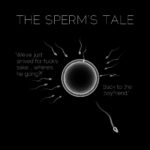Search Result
Cock and balls
Cum (spunk, semen)
 Cum is made up of sperm (made by the balls), the fluid in which they swim (made by the prostate gland) and a milky-creamy thickening agent (made by the seminal vesicles and bulbourethral glands).
Cum is made up of sperm (made by the balls), the fluid in which they swim (made by the prostate gland) and a milky-creamy thickening agent (made by the seminal vesicles and bulbourethral glands).
The fluid contains nutrients to keep the sperm alive and kicking as they battle their way towards the female egg – they’re on a lost cause there then! These include zinc, potassium, glucose, and vitamin C which gives cum its sweet, salty and very individual taste.
As you’re preparing to shoot your load, muscle contractions pump the cum from the epididymis, along the vas deferens, into the urethra which runs along the inside of your cock.
Each time we cum, we release about 2-5ml (half a dessert spoon) which contain between 50-150 million sperm. When we cum repeatedly, we produce more fluid, less sperm – which is why it tends to be clearer and more liquid.
Sexual arousal in men
When a man gets an erection, his body goes through 4 stages of sexual response: arousal, plateau, orgasm and resolution.
Stage 1: sexual excitement or arousal
A man gets an erection with physical or psychological stimulation, or both. This causes more blood to flow into 3 spongy areas called corpora that run along the length of his penis. The skin is loose and mobile, allowing his penis to grow. His scrotum – the bag of skin holding the testicles – becomes tighter, so his testicles are drawn up towards the body.Stage 2: sexual plateau
The head (glans) of his penis gets wider, and the blood vessels in and around the penis fill with blood. This causes the colour to deepen and his testicles to grow up to 50% larger. His testicles continue to rise, and a warm feeling around the area between the testicles and anus (perineum) develops. His heart rate increases, blood pressure rises, breathing becomes quicker, and his thighs and buttocks tighten. He's getting close to orgasm.Stage 3: orgasm and ejaculation
A series of contractions force semen into the urethra, the tube along which urine and semen come out of the penis. These contractions occur in the pelvic floor muscles, in the tube that carries sperm from the testicles to the penis (vas deferens). They also occur in the seminal vesicles and the prostate gland, which both add fluid to the sperm. This mix of sperm (5%) and fluid (95%) is called semen. These contractions are part of orgasm, and the man reaches a point where he can't stop ejaculation happening. Contractions of the prostate gland and the pelvic floor muscles then lead to ejaculation, when semen is forced out of the penis.Stage 4: resolution phase of sex
The man now has a recovery phase, when the penis and testicles shrink back to their normal size. He is breathing heavily and fast, his heart is beating rapidly, and he might be sweating. There's a period of time after ejaculation when another orgasm isn't possible. This varies between men, from a few minutes to a few hours, or even days. The time generally gets longer as men get older. If a man gets aroused but doesn't ejaculate, this resolution stage can take longer, and his testicles and pelvis might ache.Sexual arousal in men | NHS
The science of orgasms | AsapSCIENCE | 5 Sep 2012 | 2m 44s
How ejaculation Works | Pe Gain | 21 Dec 2017 | 1m 11s
Semen | Wikipedia
Facts about ejaculation | Very Well Health | 11 Oct 2018
Why semen changes color | Healthline | 24 Sep 2018
Twelve fascinating facts about semen | Self | 14 Mar 2016
Global sperm counts are falling. This scientist believes she knows why | Financial Times | 22 Jun 2023
How pollution is causing a male fertility crisis | BBC | 28 Mar 2023
Humans could face reproductive crisis as sperm count declines, study finds | The Guardian | 22 Nov 2022
Sperm counts worldwide are plummeting faster than we thought | National Geographic | 15 Nov 2022
Natural Harvest: A collection of semen-based recipes | Paul "Fotie" Photenhauer
Natural Harvest: Semenology - The Semen Bartender's Handbook | Paul "Fotie" Photenhauer

